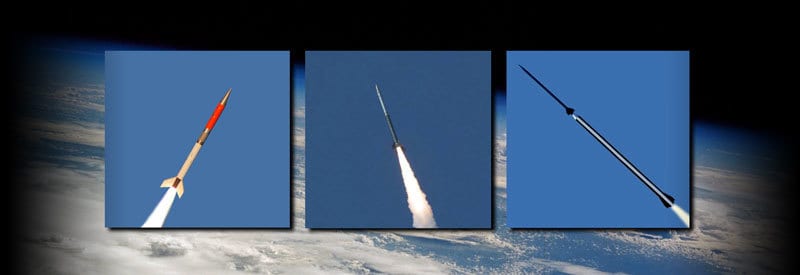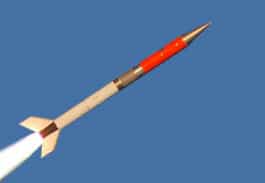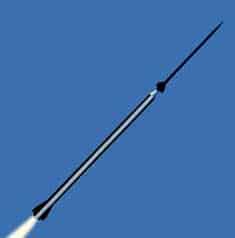Weather Rockets – Defining A Special Kind Of Sounding Rocket

Weather services primarily take atmospheric measurements in the troposphere, while weather balloons extend readings up to 40 km in the stratosphere. At higher altitudes, weather rockets are necessary.
A weather rocket is defined as a rocket-powered projectile carrying an instrument array known as a radiosonde to altitudes of approximately 75 km or 47 miles to measure atmospheric conditions. It reaches parts of the atmosphere too high for weather balloons and too low for satellites to access.
The vast majority of weather takes place in the lowest layer of the atmosphere, called the troposphere. A number of meteorological instruments measure these conditions, including weather stations, Doppler radars, and weather buoys.
Above the troposphere, atmospheric conditions in the stratosphere are still of importance. It is usually measured by weather balloons that can measure a wide array of variables, including temperature, humidity, barometric pressure, and wind speed.
More often than not, the need arises for taking atmospheric readings at even higher altitudes. Weather balloons reach a maximum altitude of only around 40 km (25 miles). They also take almost an hour to reach this height.
This brings us to a special kind of sounding rocket called the weather rocket. These specialized meteorological projectiles literally fill the space between the maximum reach of weather balloons and the lowest orbit of weather satellites.
This post examines what a weather rocket is, its characteristics, and how it functions in more detail. It also takes a look at the larger sounding rocket category in which it falls.
Weather Rocket Definition
The introduction provided some clues as to what a weather rocket is, but leaves most questions unanswered. To start understanding this meteorological "device," one needs to address its classification as a type of sounding rocket first.
The best way to summarize the relationship between the two is with the following statement:
"All Weather Rockets Are Sounding Rockets, But Not All Sounding Rockets Are Weather Rockets"
This statement may sound very confusing, but it is actually easy to understand. Sounding rockets are simply a much broader (umbrella) term for a class of smaller projectiles with similar characteristics. Weather rockets fall within this category.
Sounding Rocket Definition
This explanation on its own is not specific enough. As a result, one needs a clear definition of a sounding rocket and its characteristics before delving into the more specific subcategory of weather rockets:
What Is A Sounding Rocket?

A sounding rocket is a rocket-powered projectile that carries an instrument array called a radiosonde 48 - 150 km (30 - 93 miles) into the atmosphere to conduct scientific testing or take atmospheric measurements.
Sounding rockets usually consist of solid-fueled single-stage rocket motors and a payload that carries an array of instruments (or objects for testing) into the upper atmospheric layers of the Earth.
Also known as a research rocket, its primary use is to carry a payload up to an altitude of approximately 45 - 150 km (30 - 93 miles) above the planet's surface, from where it can conduct dedicated experiments or take atmospheric measurements.
The main advantage of reaching these altitudes is that sounding rockets are capable of accessing the part of the atmosphere between that of high-altitude weather balloons and low-orbit satellites.
(Some advanced sounding rockets are multi-stage rockets that can reach altitudes that far exceed the height at which most satellites orbit the Earth. For example, NASA's Black Brant XII is a four-stage rocket that can reach an altitude of 1 500 kilometers or 932 miles.)
The rockets follow a parabolic path, with the highest point reached called the apogee. At or near the apogee, the payload/instruments experience a brief period of weightlessness before falling back to earth. It is in this space that most experimenting/testing takes place.
Sounding (or research) rockets are used for several different purposes, from testing instruments and materials that will be used in satellites or other spacecraft, gathering astronomical data, to taking atmospheric measurements.
And it is this last point that brings us to weather rockets.
Weather Rocket Definition
The previous section described the broader category within which weather rockets fall. Although every weather rocket is a type of sounding rocket, certain characteristics differentiate it from similar projectiles.
Before looking at the features that make them unique, one needs to define what precisely a weather rocket is:
What Is A Weather Rocket?

A weather rocket, also known as a sounding rocket, is a rocket-powered projectile that carries an instrument array called a radiosonde up to altitudes of approximately 75 km (47 miles) to measure atmospheric conditions. It reaches the portion of the atmosphere too high for weather balloons and too low for satellites to access.
Also known as a meteorological rocket or rocketsonde, a weather rocket's primary purpose is to measure atmospheric conditions in the Earth's upper atmospheric layers. (Mostly in the mesosphere, but also the thermosphere.)
The radiosonde on a rocket can measure several atmospheric variables, including temperature, humidity, air pressure, and wind speed. It all depends on the specific purpose of each rocket launch, which is not always purely meteorological.
(For example, multiple weather rockets are often used to determine upper atmospheric conditions before a large satellite or manned rocket launch.)
Weather rockets consist of a rocket booster and a radiosonde that separates at a set height, from where the payload continues its ascent until reaching the apogee, where it descends with the assistance of a parachute while taking atmospheric measurements.
What makes a weather rocket especially important is its ability to take weather readings at altitudes of approximately 75 kilometers (46.6 miles). This is well above the range of weather balloons, which reach a maximum height of roughly 40 km (25 miles.)
An increased altitude is just one of several advantages over weather balloons:
While a weather balloon can take up to an hour to reach the correct altitude, a weather rocket can reach operational heights within a few minutes. Surface conditions can contaminate a balloon's radiosonde at its launch, which can interfere with readings at altitude. The enclosure of a weather rocket protects it from outside interference during launch.
How A Weather Rocket Works
The vast majority of weather rockets work on the same principles and operate in the same way. One of the most well-known rockets ever used for measuring atmospheric conditions is the Loki series of sounding rockets.
By using the Super Loki variant as an example, one will be able to get a clear picture of how most weather rockets function. The following steps describe how a weather rocket operates and the path it follows, from launch until touchdown.
- The single-stage rocket consists of two sections: The main rocket booster and the radiosonde payload, situated in the dart/cone section of the projectile.
- After ignition, the rocket launches and accelerates rapidly to approximately Mach 5 (five times the speed of sound.)
- 3At a height of 9 144 meters or 30 000 feet, the rocket motor and payload separates. The payload continues its ascent while the rocket motor falls back to the surface.
- 4The payload section ascents to its apogee at a height of 76 200 meters or 250 000 feet. (Sounding rockets' apogee varies, depending on payload and rocket output.)
- 5After reaching maximum altitude, the payload section experiences a brief period of weightlessness before it starts to fall back to the ground.
- 6As it begins to fall back to the surface, a parachute is deployed to slow down and control the descent. The radiosonde starts to perform the majority of its measurements during this period.
- 7It takes a weather rocket approximately 2 minutes to reach its maximum height or apogee but can take more than 1.5 hours to return to the surface (with the assistance of a parachute.)
- 8Upon touchdown, the radiosonde array is retrieved for reuse at a later stage. The total amount of time spend.

Although these steps are generally based on the performance and characteristics of the Loki Dart rocket, it is typical of the way in which the majority of weather operates.
Key Weather Rocket Facts
This post focused on providing a detailed definition of a weather rocket and the broader category of sounding rockets within which it falls. It also explored its characteristics and took an in-depth look at the steps involved in its operation.
The following list provides a concise summary and highlights the key information about a weather rocket.
Although this is not a comprehensive list of all the features and functions of a weather rocket, it highlights the most important facts. The more detailed information is categorized and laid out throughout the rest of this article.
Conclusion
They may be as well-known as other meteorological equipment, but weather rockets play an essential role in measuring atmospheric conditions at altitudes beyond the capabilities of weather balloons.
Weather rockets are just one category of sounding rockets. Sounding rockets are used in several different applications, from high-altitude material testing, zero-gravity experiments, to measuring atmospheric conditions before larger manned or satellite launches.
The article, however, focused on defining a weather rocket, examining its characteristics, and looking at how it functions.
Never miss out again when another interesting and helpful article is released and stay updated, while also receiving helpful tips & information by simply following this link .
Until next time, keep your eye on the weather!
